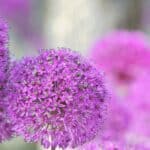Jerusalem sage (Phlomis fruticosa) is a wonderful addition to herb gardens. The yellow flowers and fuzzy greyish-green leaves are also superb for adding texture and contrast to an ornamental garden.
This fast-growing shrub produces vivid yellow flowers when it blooms from late spring to early summer, and it is often included in gardens because it attracts many beneficial insects. And this herbaceous shrub can repel pests that might feed on other plants in your garden.
A large shrub of Jerusalem sage can look rather striking all on its own. But this flowering bush will look even better if you pair it with other plant species.
If you want to enhance the beauty of this vigorous shrub, then pair Jerusalem sage with some of the companion plants we will discuss next.

What to Plant with Jerusalem Sage
It is always best to pair plants with similar growing conditions in the same garden bed so all plants can benefit equally from the sunlight and nutrients of that particular location.
Jerusalem sage is a sun-loving plant, but it will tolerate light shade. The plant will become leggy and unattractive if you grow it in the deep shade.
This herb should be planted in well-draining soil, and it is quite drought tolerant but won’t tolerate soggy areas or soil that is kept moist.
Let’s look at other plants that grow well in these conditions and alongside Jerusalem sage.
Catmint

Catmint (Nepta) is a good companion plant to consider if you want to grow a perennial garden that is easy to care for. The purple flowers and green velvety catmint leaves will also look striking next to a large bush of Phloma.
Catmint is a sun-loving perennial that can be established in just about any well-draining soil, but you should avoid clay soils because this can result in root rot. As with sage, it is drought tolerant and ideal for dryer regions or xeriscape projects.
Because catmint is shorter, with a maximum height of 10 inches, you should plant it in the front with Jerusalem sage as a dramatic backdrop.
Bee Balm

Bee balm (Monarda), also known as Oswega tea or bergamot, is another hardy perennial growing very well with Jerusalem sage. This flowering plant produces many vivid tubular flowers in colors like white, pink, red, or purple. These striking flowers will add a lot of texture to your garden and look charming in front of sage.
Bee balm should be positioned in full sun but will survive in partial shade. The plant should be positioned in well-drained soil, and it needs a bit more water than sage.
Because of its higher water requirement and shorter height, it is best to position bee balm in a row in front of your sage shrub.
Yarrow

Yarrow flowers (Achillea) are good companion plants to consider if you want to add lots of color and texture to your garden. These plants produce tiny clusters of flowers in colors like pink, red, cream, yellow, or even bicolor pastel tones that will complement your Jerusalem sage’s yellow blooms very well.
The flowers will grow well in most types of free-draining soil, and you can place them in full sun or dappled shade. They require regular watering but shouldn’t be placed in a water-logged area.
Yarrow will only grow up to 3 feet tall and should be planted before your taller sage plants.
Related: Yarrow Companion Plants
Common Sage

You can also pair Jerusalem sage with a common sage (Salvia). These two herb varieties will grow very well together. The purple spiky flowers of common sage varieties will look striking next to a large bush of yellow-blooming Jerusalem sage.
This type of pairing is excellent for adding color to a protective barrier you can create around a vegetable garden. Sage is perfect for repelling all common garden pests, and Jerusalem sage is deer-resistant.
Common sage grows very well in direct sun and free-draining soil. Thai herbaceous shrubs can be grown next to or before your Jerusalem sage to create a colorful mixed hedge in your garden.
Daylily

Daylilies (Hemerocallis) are good companion plants to add to your garden if you want to enhance the aesthetics of your garden beds. These flowering plants produce vivid flowers in colors like red, purple, yellow, or orange and their spiky leaves will add lots of texture to your garden.
These flowers grow very well in full sun but they can also develop well in light shade. They need to be planted in well-drained soil and can survive spells of drought.
Some varieties of daylilies are quite tall and can be grown amongst Jerusalem sage shrubs or in front of them if your shrubs are particularly tall.
What NOT to Plant with Jerusalem Sage
Jerusalem sage doesn’t get along with all plant species. If you establish shade-loving plants next to sage, these plants are likely to wilt and die because they cannot tolerate the extreme heat and drought that sage flourishes in.
It is best to avoid all shade-loving plants in an area where you are planning to establish a hardy perennial like sage.
Final Thoughts
Jerusalem sage will grow well alongside many plant species like bee balm, catmint, yarrow, common sage, etc. It is a terrific herbaceous plant to include in your garden if you want lots of color or need something that thrives.
We hope this guide made selecting the best companion plants to grow next to your Jerusalem sage easier.
If you add other types of herbs to your garden bed, look at our other guides and discuss other great plant combinations to make for a more striking and valuable garden.
See more:







